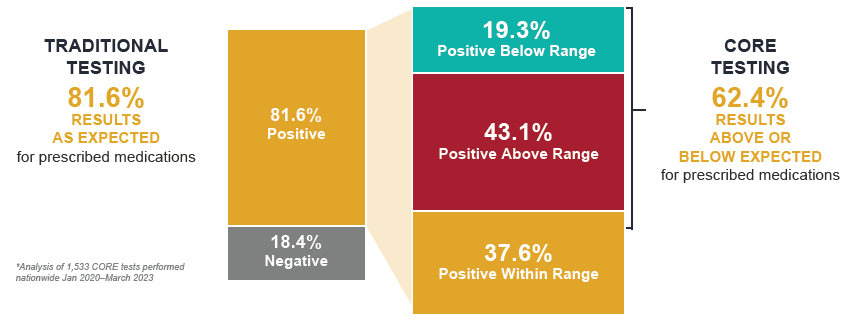CORE Steady-State Oral Fluid Testing

Increase Your Visibility Into Prescription Adherence With Steady-State Oral Fluid Testing
CORE (Navis Comprehensive Oral Fluid Rx Evaluation®) is the first patient-monitoring tool to use saliva samples to provide insights to providers if medication is present at a level consistent with the prescribed dosing regimen.
Until CORE, most providers were not able to distinguish between patients taking only some of their medication and patients taking their medications as prescribed, or if there are metabolic or health issues that need more investigation.
CORE is a breakthrough in the medication monitoring industry, as no other lab is able to determine from a non-invasive test, like saliva, if medication is present at the steady-state level consistent with the prescribed opioid treatment plan.
In comparison, traditional urine or saliva drug tests cannot provide this level of information or detail. They simply report the presence or absence of a drug, not if it is being taken consistently as prescribed or if there are metabolic issues occurring and more investigation is needed.
Data released in 2023 illustrates the difference between traditional drug testing and CORE testing.*
From a traditional testing perspective, 81.6% of samples tested were classified as positive for the prescribed opioid, meaning the medication was present in the patient’s system at the time of collection.
However, when the same positive samples were tested using CORE, 62.4% that were previously classified as positive were found to be above or below the expected range (at a level consistent with the prescribed dosing regimen.) 19.3% of patients who tested as expected with the traditional test were found to be below the expected range and 43.1% above.

What Our Clients Are Saying
CORE is an evolutionary step in drug testing because it gives more specific information than urine or standard oral fluid tests. Knowing which patients are departing from their prescription regimen gives me a natural opening for a productive conversation with the patient about how and when they take their medication.
Most often the patient has just misunderstood the plan and the correction is relatively simple. CORE results give me the opportunity to take a situation that I wouldn’t otherwise have known was problematic and turn it into one that supports the patient’s health.
What I find most valuable about CORE is that it provides me with more information about if the prescriptions I write are more likely being taken as directed.
I am able to have better conversations with my patients when I have CORE results to discuss. Specifically, I just had a patient that was below the expected range with CORE. It turns out he was only consistently taking four of the six pills I prescribed daily. CORE helped me reduce the number of pills I was prescribing, while most importantly, ensuring appropriate patient care.
The issue that we face in the pain management world is the limited ability to understand if patients are actually taking their medications as directed.
Previously, all we had for non-invasive testing was standard urine or oral fluid options, where the assumption was that a positive result for a prescribed medication meant everything was good with the patient. Most pain providers test their chronic pain patients regularly to make sure patients are taking their medication, or that they are not taking something else that could create a lethal combination.
